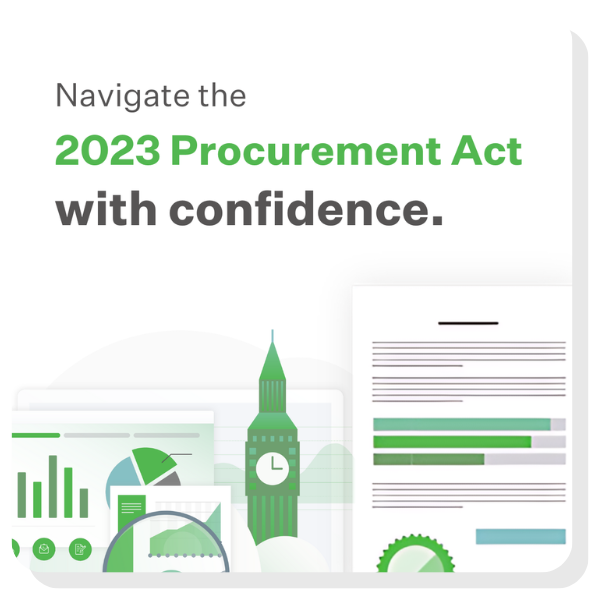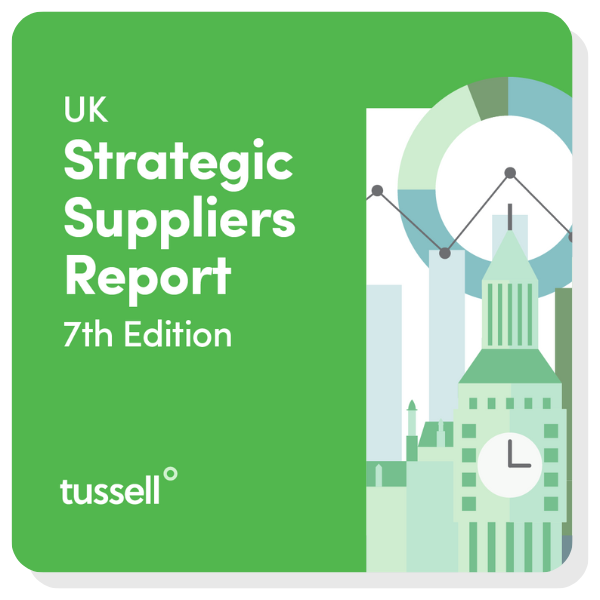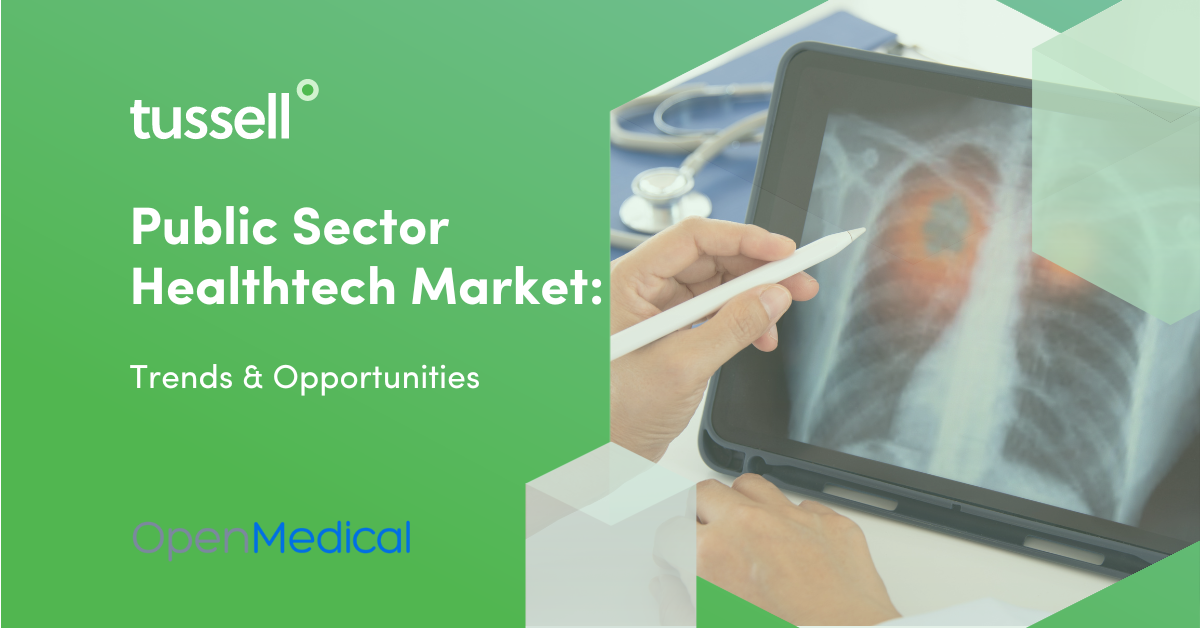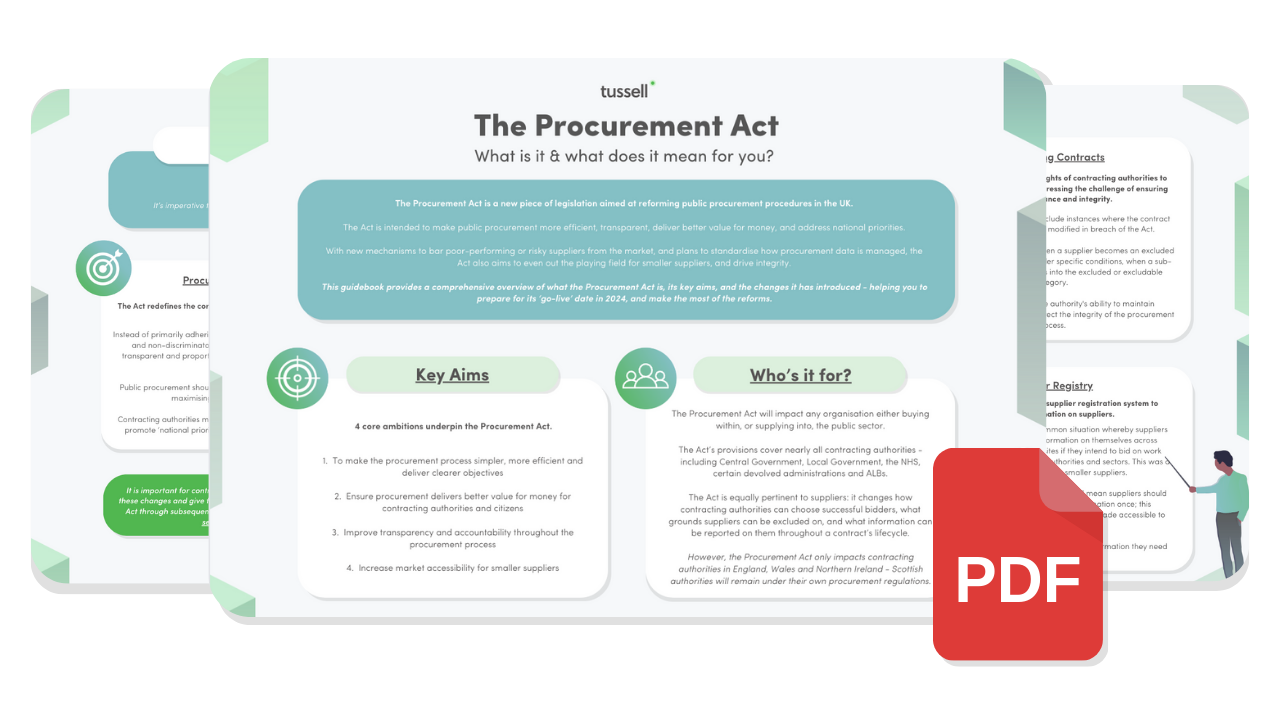Healthtech is a developing market in the public sector, growing 305% in the last 5 years!
We’ve teamed up with our healthtech expert partner Michael Shenouda - Commerical Director at Open Medical - to provide expert insight into the world of healthtech in the public sector looking at the current market trends and the drivers behind these, keys to success and the future within the sector.
Skip ahead to read about:
- What does the healthtech market look like today?
- What trends are driving this market?
- What are the keys to success in this sector?
- What does the future have in store for healthtech in the public sector?
A little about our partner:
Open Medical "specialise in developing and implementing bespoke, end-to-end, patient pathway and clinical workflow solutions, for all specialities, across all care settings. Our market-leading, fully interoperable digital platform, PathpointⓇ, is used across hundreds of healthcare institutions to prioritise, synchronise and visualise speciality team workflows, for the best integrated, data-driven care and future service planning."
Michael Shenouda is an industry leader and surgeon with over 15 years of experience in healthcare. He has a wealth of knowledge of the corporate, technological and financial challenges in the digital health industry, including understanding the complex stakeholder landscape. His present research interests are in innovative healthcare technology and clinical patient pathways, promoting data-driven healthcare and ensuring digital solutions are supported by robust evidence generation.
What does the healthtech market look like today?
Contract award data:
Contract award data from Tussell's market intelligence platform shows us that the healthtech sector has been and is continuing to grow both in terms of contract award value and the volume of contracts awarded.
In 2016, the total value of healthtech-related contract awards was £395 million, increasing to £1.2 billion by 2021 - this is a huge increase of 305%! Similarly, the volume of awarded contracts increased from 291 in 2016 to 1,600 in 2021 - an increase of 449%!
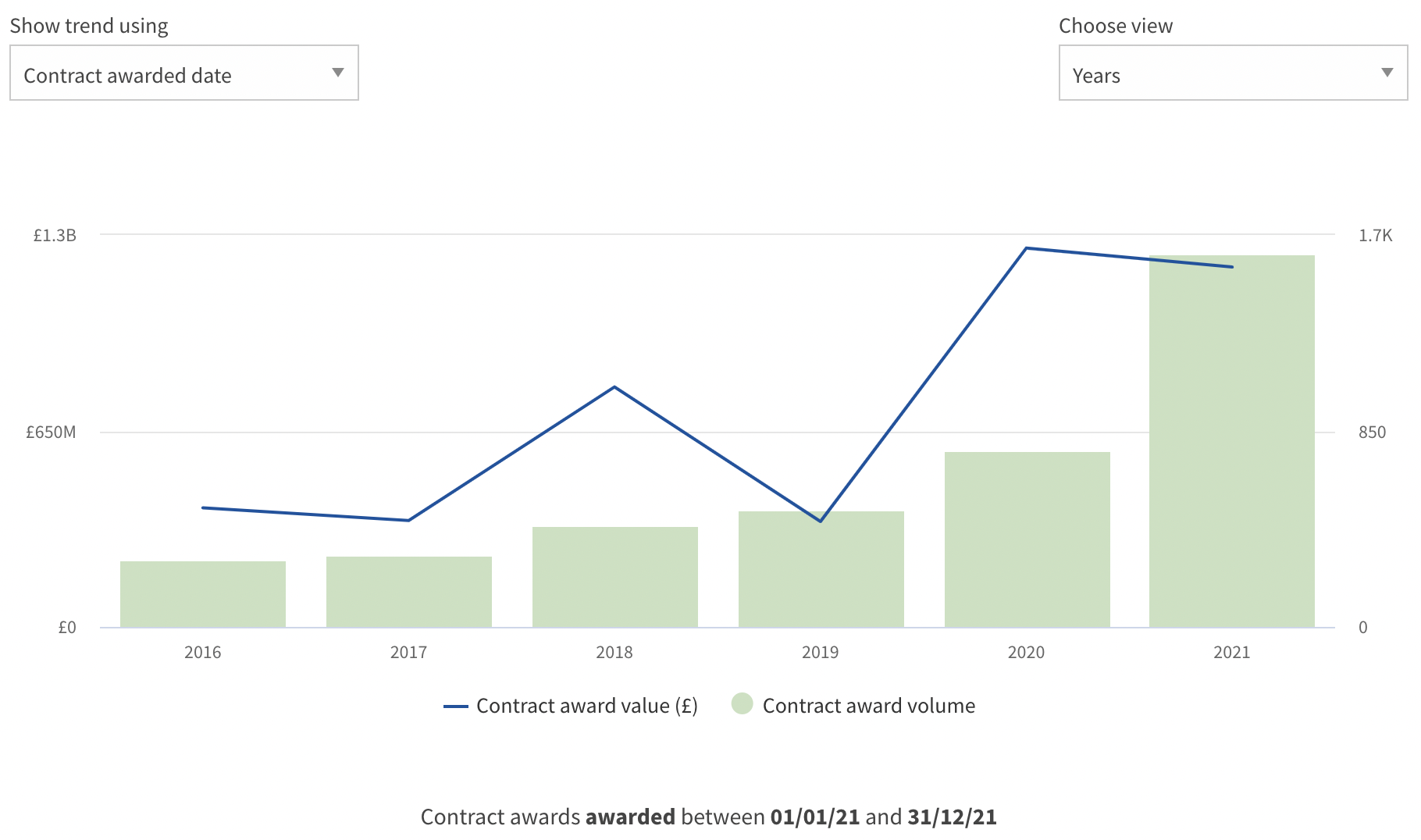
*These results were generated using a search for any NHS contracts that fall into multiple healthtech-related CPV codes including, 302000 (computer equipment & supplies), 51610000 (installation services of computers & information-processing equipment) and 48000000 (software package and information systems).
With just one click on the Tussell platform, we can see the same contract award data but displayed by quarter.
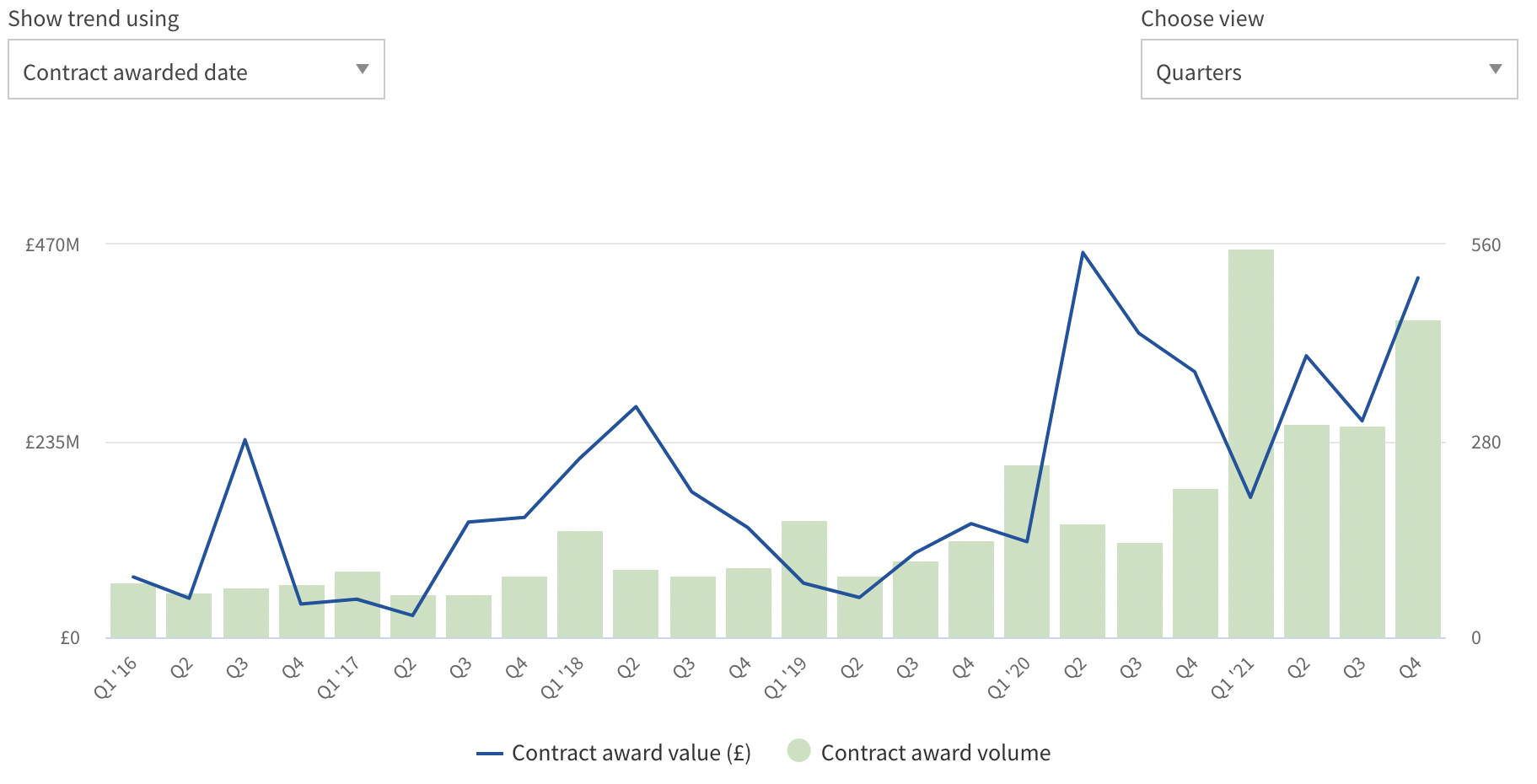
From this view, we can easily see a pattern: Q1 of each year is when the most contracts get awarded.
Below is a breakdown of the largest buyers and largest suppliers of healthtech, by total contract award value across the same period.
Top buyers:
|
Contracting authority |
Organisation type |
Total contract award value |
Top supplier |
|
NHS National Services Scotland |
NHS |
£379mn |
|
|
UK Health Security Agency (UKHSA) |
NHS |
£245mn |
|
|
Manchester University NHS Foundation Trust |
NHS |
£193mn |
|
|
NHS Shared Business Services |
NHS |
£193mn |
|
|
University College London Hospitals NHS Foundation Trust |
NHS |
£188mn |
Innova Medical Group Inc |
Top suppliers:
|
Supplier |
Total contract award value |
Top customer |
|
EPIC Bristol Limited |
£289mn |
Business Services Organisation |
|
SOFTCAT PLC |
£256mn |
NHS National Services Scotland |
|
Cerner Limited |
£149mn |
Wirral University Teaching Hospital NHS Foundation Trust |
|
Health Innovation Partners Limited |
£145mn |
Torbay & South Devon NHS Foundation Trust |
|
IBM United Kingdom Limited |
£145mn |
London Borough of Harrow |
Frameworks
A critical route-to-market in this sector is through frameworks. At Tussell, we've matched tens of thousands of public sector call-off contracts to the framework agreements they were awarded under, meaning Tussell is the only market intelligence platform to offer insights into the true value and usage of frameworks. Using this data tells us that between January 2016 and December 2021, 130 healthtech-related call-off contracts were awarded with a total value of £855 million across 130 frameworks.
Out of a total of 3,926 contracts awarded between 2016-2021, over one-third of these contracts (34.51%) were awarded via a framework. With this many contracts being awarded through frameworks in this sector, it is critical that you are capitalising on these frameworks.
Being on the right frameworks in the public sector has never been more important for suppliers who want to do more business with government. To learn more about how to find the most used frameworks in your sector, check out our how-to guide.
Top Frameworks:
By total call-off award value, the most valuable used healthtech-related frameworks during this period were:
-
Clinical Software (and Hardware) Solutions for Use in Healthcare Framework (£78 million)
-
G-Cloud 12 (£71.4 million)
-
G-Cloud 11 (£62.7 million)
-
RM6100 Technology Services 3 (£49.3 million)
-
Clinical Digital Solutions (CDS) for the Integrated Health Economy Framework (£49.2 million)
By total call-off award volume, the most valuable used healthtech-related frameworks during this period were:
-
G-Cloud 12 (266 call-offs)
-
Framework Agreement for the Provision of Enterprise Level ICT Solutions 2019 (120 call-offs)
-
RM6068 Technology Products and Associated Services (89 call-offs)
-
RM3808 Network Services 2 (80 call-offs)
-
G-Cloud 11 (77 call-offs)
What trends are driving this market?
Impact of COVID-19:
The COVID-19 pandemic understandably increased demand for healthtech in the public sector.
As Michael explains, the COVID-19 pandemic "expedited the need for a fully integrated digital ecosystem in healthcare. The healthcare industry was already headed towards digitalisation prior to COVID, but the pandemic spurred healthtech organisations to innovate and adapt to new models of care at rate that would have otherwise taken 5 to 10 years." As we can see from the data from the Tussell platform, the growth rate from 2019 to 2021 was exponential following rise of COVID-19.
The pandemic highlighted a gap in the market and a way to improve healthcare infrastructure through technology. Michael added "Healthcare providers quickly embraced new technologies to enable new methods of working, removing adoption barriers. Healthtech suppliers were therefore able to accomplish significant progress without the obstacles that would have existed if it had been attempted before COVID."
Additionally, in the same way that the pandemic affected other tech sectors, Michael noted that "remote or hybrid working is currently a major trend across industries, and more people, including the elderly population, are willing to look at different ways of providing and receiving care, for example video consultations and receiving documents and questionnaires online." Within the healthcare sector this has been because of "constraints and a shift toward regional models of care", Michael pointed out.
The pandemic was unlike any other event in modern history and spurred the need for infrastructure that would support the changes society was making in order to adapt.
Changing priorities:
"There is also a move toward sustainable healthcare; people are beginning to realise the carbon impact of healthcare provision, and the need to find ways of reducing this where possible", Michael explains. Sustainable healthcare has gained importance across the public sector. It aims to deliver high-quality and affordable care without damaging the environment.
As Michael summarised: "There is also a shift to understanding the purpose of technology in a different way, which is not simply digitising processes, but transforming them." It is paramount that suppliers understand the driving forces and key players within the market, and what their needs and aims are. "Technology should be an enabler to empower clinicians to deliver better care, and patients to interact with their healthcare providers in the most appropriate time and place."
Big data:
"Data is another emerging trend; understanding local and/or regional data from an operational metric perspective and service improvement. Then there is the trend towards big data." With Tussell's market intelligence platform you can easily analyse big data through our easy-to-use search filters, saved searches and an array of data layouts. Within the healthcare sector Michael exemplifies how big data is used - "population health data to target specific diseases in a preventative manner."
Key Documentation:
There are a variety of government bodies that work together to create cohesive set of regulations and recommendations for healthcare implementation and development within the public sector:
-
National Data Guardian 2021-2022 Report - written by the NDG, August 2022
-
Harnessing technology for the long-term sustainability of the UK’s healthcare system: report - published by the UK government's National Office Science, August 2021
-
Making it Happen: Delivering Future Innovation in Healthtech Report - written by the Association of British HealthTech Industries (ABHI), June 2021
What are the keys to success in this sector?
Understanding and acting on market trends is a great start to making an impact in a sector. However, you also need to understand the lay of the land and the keys to success in the sector whilst bearing in mind the common pitfalls.
Michael pointed out 3 major mistakes that healthtech suppliers make: "(1) neglecting the end user as a stakeholder, (2) not leveraging the benefits of the cloud, and (3) digitising rather than transforming healthcare processes."
User-centricity:
It is clear that "digital solutions need to be user-centric" but this is where many suppliers often miss the ball - as Michael reminds us, the end user is a stakeholder so the system must be designed with them in mind. He also went on to point out that "digital solutions must provide a valuable return on investment for the buyer, and meaningful benefits for the end users - who are not always the same as the buyer."
The cloud:
His second piece of advice is relevant for anyone within the public sector IT and technology sectors using the cloud: "Using cloud services helps support rapidly scalable, flexible, and cost-effective solutions that can respond to changes in how we work, but this resource is underutilised by healthtech suppliers." To find out more about the public sector cloud services market, check out our sector analysis blog.
Digital transformation:
Michael also raises a crucial aspect that is particularly paramount and more complex within the public sector healthtech market. "True digital transformation occurs at all levels, from individual departments, across hospitals and specialities, and across regional pathways. The needs are different for individual departments, teams, or specialities, but once processes are adapted and optimised for present-day healthcare provision, utilising and layering in the available technology becomes much easier".
The key to achieving this is to stay ahead of the curve and understand the market trends both within the public sector healthtech market and the wider public sector more generally. The creation of a "future-proofed system that can stay current with guidelines and scale up innovation frequently as technology evolves" is at the foundation to avoiding this pitfall.
An overarching comment leading on from Michael's last piece of advice was to realise that "this journey is not a one-off, it will adapt and evolve constantly over the years".
What does the future have in store for healthtech in the public sector?
A holistic trend that will impact the future of the healthtech sector is the change in mindset that is happening. As Michael said, "There is also a greater focus on software as a medical device, and what that entails in terms of machine learning, predictive analytics, and particularly clinical decision-making support." A new mindset will change the thought process behind developments and decision-making within the market - technology's sole purpose is no longer to "simply digitis[e] processes, but transform[s] them".
Brexit repercussions:
The impact of Brexit is still being felt across the procurement world and highlighted the need for an overhaul. Following Brexit, there has been numerous incentives started to "attract and incentivise both domestic and international companies to set up services in the UK". With 62% of all imported healthtech used in the NHS coming from the EU (as of July 2018), there is a clear gap in the market for suppliers post-Brexit.
Government legislation:
In August 2021, the UK government wrote the Harnessing technology for the long-term sustainability of the UK's healthcare system: report which highlighted some of the problems facing the industry and priorities for change. The 2 areas they identified were:
1. "Supporting a step-change to improve and maintain population health, centred around new ways of engaging and supporting individuals and communities, enabled by data and evidence."
2. "Re-engineering the health system to support integrated 'pathways' for prevention, treatment and care and better outcomes for individuals".
The recommendations this report included were:
1. "The government should set up at least 2 significant scale demonstrators to test the system-wide application of healthcare technologies
2. "The government should establish a 'National Centre for Health System Improvement' to build capacity and skills for system transformation".
It is important for any suppliers working in the healthtech market or any suppliers looking to break into this market to keep an eye on the impact of this report as it could spur some fundamental changes within the sector. Staying up-to-date with government activity and legislation in this market is crucial.
Impact of new documents:
A key document that will shape the development of the public sector heathtech industry in the future is the Making it Happen: Delivering Future Innovation in Healthtech report from the Association of British HealthTech Industries (ABHI).
The ABHI identified 3 key drivers for change:
-
Sustaining positive pandemic response innovation
-
Building an early diagnosis culture
-
Increasing the delivery of remote care
In general, the report placed emphasis on the need for supporting value-based procurement within the public sector that capitalises on the benefits that technology can provide not only in the short-term but in the long-term too for sustainability. It highlights the current overly "transactional" mindset that the government has when dealing with healthtech contracts and suppliers. By following the recommendations of ABHI and moving away from the transactional mindset, SMEs would have increased access to appropriate finance and the sector would be more open to innovation. The pandemic proved the success of overdue innovation - "It is only by pushing forward do we find out what is possible and do the right thing for patients, science, the NHS and our economy." (ALBI, 2021).
The new G-Cloud 13 framework:
A final thing to watch out for in this sector is the introduction of the new G-Cloud 13 framework which was introduced on the 9th November 2022. This framework replaced the G-Cloud 12 framework so will likely become one of the main frameworks for the procurement of healthtech-related services and products as well as the wider IT and Technology sector. G-Cloud 13 has new and improved terms and conditions that will allow for more provision of day rate inclusion and the inclusion of the latest procurement policies (including social value and prompt payment).
If you missed out on joining the G-Cloud framework this time round, you can look to work in partnership with other companies who are on the framework and make sure you keep an eye out for the G-Cloud 14 applications!
The need for better efficiency and decision-making has never been more paramount - healthtech has risen as a crucial answer to these calls. If you're a healthtech provider, there's never been a better time to enter this ever-growing marketplace - just be sure you heed the advice of the expert above.
*
If you want to make inroads into this market, you'll need decision-ready data on your side to decide who to target, know who you'll be up against for opportunities, and what the best routes to market for your business are. With Tussell, you can analyse public spend, contract awards, favoured frameworks and more, helping you make more informed decisions and strategies when selling to the public sector, at any time.
Book a personalised demo with our team to see how Tussell can unlock public sector insights and opportunities for your business.




